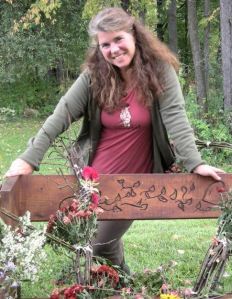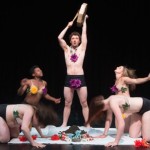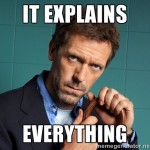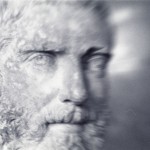When saw that Jason Mankey interviewed atheist Pagan Amy B. at Raising the Horns, I was first excited, and then horrified. Personally, I tend to avoid the label “atheist Pagan” for the same reason that many non-theists avoid the term “atheist”. I’ve seen “atheist Pagan” used closely with “secular Pagan”, which does not describe me at all. But even though I don’t identify as one, there is much that I have in common with self-described atheist Pagans, including a commitment to philosophical naturalism and humanism. So, that was why I was excited to read Jason’s interview of Amy. And then I read this:
With no belief in the supernatural, why do you go to rituals?
Because I see religious ritual primarily as a form of entertainment. Mega-church worship services and high Catholic masses can be dazzling, but for sheer joy and fun, Pagan ritual has them all beat. Properly done, Pagan ritual involves an all-body experience and lots of theatricality.
When I read that, I thought, “Crap! This will confirm the worst fears of theistic Pagans about non-theists.” I commented on Jason’s blog and expressed my concern, and I was glad to see other non-theists speak up as well. It’s my hope that those reading the interview will appreciate that Amy is just one type of non-theistic Pagan, and is not necessarily representative. For one thing, she describes herself as a “secular humanist”. While I am a humanist and a humanistic Pagan, I’ve never described myself as a “secular” anything. Indeed, my Paganism is a reaction against secularity. Amy’s ritual-as-entertainment approach, I think, is a function of her secularity, more than her atheism.
In any case, this is not a personal criticism of Amy B. She is entitled to believe and practice as she sees fit. I have no problem with her self-identification as a Pagan. And I would probably enjoy doing ritual with her. I just want to emphasize that not all non-theistic or a-theistic Pagans are secular or aesthetic Pagans like Amy. Many non-theistic Pagans, including myself, have a deep sense of spirituality and treat ritual as something sacred.
But rather than tell you more about what my own beliefs and practices, I’d like to instead introduce you to the recent writings of three non-theistic Pagans who have written about their beliefs and their practices. You may or may not know them already. They are non-theistic type Pagans whose approach to the gods and ritual, while non-theistic, nevertheless is more reverential than what Amy B. described in her interview with Jason.
Áine W.
On her blog, The Spinning of the Wheel, Áine W. describes herself as a naturalistic Pagan, a pantheist, an an atheist. Throughout her posts, Áine tries to balance her “pantheistic leanings” with her atheism. She explains that her spiritual practices are largely metaphorical, and she feels that religious ritual is beneficial psychologically. She writes about reclaiming ritual as part of her reclaiming her Pagan identity: “I believe that one of the core reasons for my spiritual leaning stems from an innate human need for ritual, particularly when connected with mythologising or storying the universe.” Áine’s evolving practice is strongly influenced by her Wiccan background and by Glenys Livingstone’s Pagaian Cosmology. She gives an outline of her evolving core ritual here.
Áine explains, in her recent post entitled “Choosing Metaphors: theistic language in non-theistic spiritual practice”, that as a pantheist, she acknowledges “divinity”, but not “deity”. Divinity, for Áine, is the Cosmos, the universe, or existence, which she calls “Gaia”. In spite of her non-theistic beliefs, she does use anthropomorphism in her rituals and devotions. For Áine, deities are “metaphors of physical phenomenon or abstract concepts” which she meditates on, dedicates words to, and lights candles for. She is comfortable using theistic language because “it adds meaning to my rituals and my feeling of connectedness with what I consider to be the divine.”
In an earlier post this past May, entitled “Emotional Pantheism: where the logic ends and the feelings start”, Áine writes about how she has tried to balance her secular life and her spirituality, or her logical side and her emotional side, represented respectively by her atheism and her pantheism. She explains that, while she does not “believe” in divinity, she does feel it:
“… although there are theological and philosophical theories and intangible concepts that excite me and are meaningful to me, I’m not sure that I could be said to believe in divinity in any real way.
“But when it comes to how I resonate emotionally, I have very strong pantheistic feelings. Although I may not see divinity as something that can even be defined, let alone proven, I feel as though the universe is divine. It is not something I believe in the way that I believe in science and physics and the physicality of my day-to-day existence. But it is something that I feel at my very core. It is an emotional response to awe, to beauty, to mystery. And that emotional response is very strong in me.”
While she is not willing to take leaps of faith logically, Áine is willing to take emotional leaps of faith, by opening herself to experience the trans-mundane without judgment. She concludes: “So when I perform ritual – when I light my altar candles and utter words of dedication and devotion – I am not merely marking a changing season or an astronomical event. I am, emotionally, reaching out the divinity that I see in the Cosmos.”
I love Áine’s distinction between logical atheism and emotional pantheism, and how she is able to bring these together into a kind of uneasy balance. There is a kind of ambivalence about spirituality in Áine’s writing that I really identify with. Like my own, her relationship with these two sides of herself is constantly evolving. In a post entitled, “Symbiosis: the two of cups”, she writes:
“I still somewhat see my spirituality as my shadow, or a part of my shadow self. It feels sometimes like an outpouring of everything I have been rejecting as I mature – irrationality, reverence, magic, possibility. I become, in ritual, a version of myself that nobody else ever sees, something that is quite opposite to much of what I feel makes me myself. Through ritual and reverence, I reach out a hand to that part of me that revels in mysticism and the unknown, that thrills at the thought of dark mysteries. I experience the dark joy of life.“
In spite of this ambivalence about her spiritual side, it is clear from Áine’s writing that she is a deeply spiritual person. And her approach to ritual, whether it includes anthropomorhism or not, is profoundly reverential.
Treeshrew
On his blog, Endless Erring, Treeshrew describes himself as an aspiring “naturalist druid” and “atheist druid”. He explains that does he not believe in gods, spirits, or magic, but loves nature and finds the universe amazing. He believes that science is the best way to understand reality, but contemporary druidry helps him create a “a sense of meaningful relationship with the inter-connected natural world of which we humans are a small part.”
Treeshrew defines his own spirituality as “deep sense of awe and wonder at the natural world.” The spiritual life, for him, is
“one fully engaged with living and one which seeks inspiration, or Awen in a Druid context, from the natural world. And whilst I do not believe in anthropomorphic gods in the sky, I do believe in the intricate connections of the forces of nature, the life-force of the universe, the energies that permeate all things.”
Treeshrew wrote about his struggle with the question of anthropomorphism in a post earlier this year entitled, “Gods, atheists and Muppets, oh my!”. He describes his struggle to figure out how, as an atheist, to deal with the presence of deities in the prayers and rituals of his druid tradition. Treeshrew explains that for him, “deities are characters in stories.” But, he goes on:
“Stories are important. Stories are a human universal and they connect us to each other and our past. Stories impart wisdom and teach life lessons. Stories can reveal ‘truths’ that facts alone cannot. … In ritual I am willing to ‘suspend disbelief’ just as I do when reading a book or watching a film. I am happy to enter into the immersive experience, but once the ritual is done, I return to reality. The gods and goddesses live in our minds only and we can carry their inspiration within us.”
According to Treeshrew, even though the gods are human creations, they are powerful symbols. He writes, “What is important is that they point beyond themselves to the awesome powers of the natural world, the vast universe of which we are a part.”
Through ritual, Treeshrew explains in another post, we re-enchant the world, “bringing meaning and relationship back into our understanding of nature.” In a post entitled, “Nature Worship … what’s the point?”, Treeshrew writes that the purpose of ritual, for him, is not to interact with gods or spirits, but to interact with nature:
“When we gather in a group for ritual, we interact with each other (humans are part of nature after all), and we re-enact our beliefs that nature is sacred and should be cared for. Ritual can serve as a reminder of this. I don’t perform ritual to ‘get’ something for myself from nature, I do it to align my thinking closer to nature and change the way I relate to the world.“
Worship, writes Treeshrew, “is thus not a give and take business transaction, or a wish-granting mechanism, but simply an acknowledgement of something greater than oneself, and a surrender to it.” Treeshrew writes in another post that far from being opposed to science, religious ritual helps us to experience the wonder and awe revealed to us by scientific discoveries on an emotional level as well as an intellectual one.
Treeshrew’s approach to the gods as “characters in stories” need not be seen as reductive. They symbols that point beyond themselves to the natural world and help us to experience truths that cannot be communicated in other ways. Facilitated by these symbols, ritual enables us to “enact our beliefs” (great phase!) in the sacredness of nature and our connection to it.
Peg Aloi
Peg Aloi, also known as the Media Witch, blogs at The Witching Hour at Patheos where she writes primarily about media of interest to Pagans. She is also a poet, singer, freelance film critic, professor of media studies, and author. Until her recent post, “Adventures of a Non-Deist, or, Why I Don’t ‘Believe’ in the Gods”, I didn’t know anything about Peg’s theology or her practice. Peg was an atheist before she became Pagan. She was drawn to Neo-Paganism by a love of ritual, nature spirituality, and environmental activism. The worship of the gods or the Goddess did not feel right to her, so she came to identify as a “non-deist” witch.
In spite of this, Peg does call on various gods and goddesses in ritual. And while she does not worship the gods, she does have statues of them on my altars and images of them on her walls. Peg describes them as “forms of inspiration”:
“I like to focus on their characteristics and narratives to try and bring about change in my life: identifying with Pomona to bring abundance, for example, or Artemis to find peace in solitude, or Herne to connect with the wilder unspoken aspects of nature. I give them places of honor and look at them and think about them. But I do not worship them.”
Peg explains that, in spite of the eclecticsm of her devotions, ritual allows her to participate in the ancient mythology of the gods:
“Even as I write rituals, crafting them from poetry I gather from a plethora of writers or that I create myself, even as I describe the attributes of these deities and write passionate paeans to them, I do not think of what I do as worshipping these figures. I think the most accurate way to describe it is to say that I engage with the energy and imagery of these deities: I take part in their mythology, their ancient story, which has been reborn around the world.“
Through ritual, the ancient names, imagery, and stories of the gods can be drawn upon to re-myth our own lives, and to effect personal and, ultimately, social transformation.
The practices each of the Pagans above is a unique and beautiful example of a non-theistic Pagan religiosity. My own beliefs about the gods and about the purpose of ritual, while somewhat different from each, are also very similar to theirs. They are non-theistic, but they are neither secular nor merely aesthetic. Their approach to ritual is distinctly religious. Their inclusion of theistic language in their rituals is neither facetious, nor a form of play-acting. It is, rather, part of each of their attempts to reach beyond themselves to experience the ungraspable mystery of existence which is in the natural world and within themselves.
(If you’d like to know more about non-theistic Pagans, I highly recommend “Care and feeding of your atheist Pagan” by Jeffrey Flagg, as a great place to start.)

















